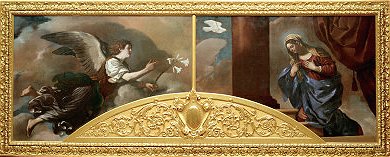His paintings show a command of the subtle effects of light and dark, with his figures revealing a wide variety of gesture and expression, the result of the artist's grasp of human psychology. Largely self-taught, Guercino was influenced early on by Ludovico Carracci and his cousin Annibale. What seemed to attract patrons to Guercino paintings was their bold naturalism, broad brushwork, powerful chiaroscuro and daring compositional inventiveness. Guercino's style changed dramatically during his long career. His early works are robust in handling, rich in muted colors and dramatic in lighting and composition. He developed a dark, painterly manner which can be seen in the Ringling Annunciation, however, after a stay in Rome (1621-23) his paintings began to alter as he came under a more classical style. There was a lightening of his palette and a tendency to make the spatial setting of his figures more lucid. The Annunciation is a harmonious expression of all the forces that shaped Guercino's mature art. After the death of Guido Reni in 1642 Guercino moved from Cento to Bologna where he took over the studio of Reni and became the city's principal painter for the next quarter century. Guercino was also one of the most brilliant draughtsmen of his age. Subject: Painting: Mary is seen kneeling on the steps of an abstract architectural setting against an expanse of sky rather than in the scene's customary interior. The oversized angel fills the whole left side of the picture. Guercino made effective use of interval between the two figures. The gap serves to carry the message from the angel to the Virgin, whose gesture reflects her reception of its importance. The Holy Ghost in the form of a dove hovers above. This painting reflects the baroque classicism of Annibale Carracci, whose style of rugged naturalism influenced Guercino early on. We see in the picture a classicism, however, which tames the baroque dynamism usually seen in a rendering of the subject. The angel in profile is classical as is the Virgin's subdued humility. The figures have a rounded fleshiness and the idealized features that are typical of Guercino's work of around the 1620's. These figures also remind one of the realism of Caravaggio in their physical solidity and dramatic presence. Historical Context:
|
